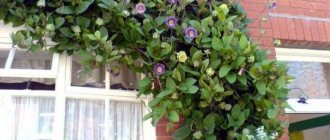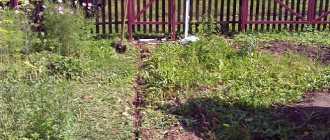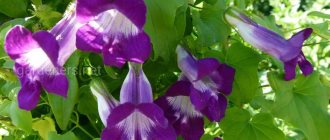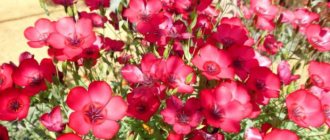For landscaping the garden, creating green walls, gazebos, canopies, many liana-like plants are used in gardening. Depending on the requirements for the vine in terms of appearance, maintenance, care and reproduction, you can choose a plant to your liking. At the same time, you can rarely find azarina in the design of a personal plot. This beautiful ornamental plant, unfortunately, is not very popular among gardeners. Azarina, or in other words Maurandia, is underestimated due to its lack of popularity, but upon closer acquaintance, the creeping plant captivates with its abundant flowering, dense foliage, and flexible stem. The bell-shaped flowers of climbing azarina delight with a variety of shades and are a good addition when decorating a garden plot.
Azarina climbing - Mexican beauty
The climbing azarina , Asarina scandens or Asarina semperflorens, is native to Mexico. This is the most common species of the Azarina genus, a member of the Plantain family.
In some sources the plant can be found under the name Maurandia or in Latin Maurandia.
As the name suggests, Asarina climbing is a climbing vine. Under favorable conditions, its shoots can stretch up to 7 meters in length. The plant is very decorative.
It has thick, velvety, heart-shaped foliage, against which tubular flowers bloom, looking like delicate “gramophones.” They are small in size but very bright.
Many varieties of climbing azarina with various flower colors have been bred:
- "Red dragon" - red-pink
- "Sky Blue" - bright blue
- "Mystic Rose" - pink
- "Joan Loraine" - violet-blue
- "Bridge's White" - snow-white
Another advantage of climbing azarina is its versatility. Most often it is used for vertical gardening of arches, fences, walls, gazebos and balconies, using support.
However, if the vine is planted in a large hanging basket or on an artificial hill, it will turn into a luxurious hanging plant. There is also a third option for using the amazing azarina - ground cover cultivation. In two weeks, the vine can cover a 1 square meter plot of land with a continuous carpet of greenery.
Types and varieties
Since climbing azarina is not very popular among flower growers, only a few species can be seen in Russia.
Azarina reddish erubescens
The climbing stem reaches up to 3 m in length. A distinctive feature of the vine is that the lower part of the stem becomes woody. The leaves are drooping, green, rounded-triangular in shape with characteristic heterogeneously torn edges.
The shape of the flowers is wide-elongated, bell-shaped. At its disposal, the Azarina erubescens liana has only one petal color - pink, the tubular part is paler, predominantly white. The length of the bud reaches 7 cm. The liana prefers shaded places with well-moistened soil.
Azarina reddish erubescens
Azarina Barclay
The fastest growing type of vine, one shoot can stretch up to 3.5 m in length. Moreover, the branched stem occupies up to 2.5 m of surface in width. The leaves of the Barclay's azarina vine are ivy-like, triangular-heart-shaped. The flowers are large, up to 7 cm in length, tubular, bell-shaped with bright petals of pink, violet, purple color, with a characteristic light throat. Flowering period from mid-June to October.
Azarina Barclay
Azarina climbing
The most common type of vine. Azarina climbing grows up to 3-4 m. The leaves are small, dark green, dull, fleecy, heart-shaped with curly edges. The leaf shape is often compared to ivy leaf blades. Azarina climbing has a flexible, curly, branched stem; its leaves on long cuttings wrap around and cling to any support. Flowers are up to 3 cm in length, bell-shaped, white, blue, pink and purple. After the seeds germinate, the first flowering occurs 3.5-4 months later, so experienced gardeners prepare seedlings in early spring in order to enjoy lush flowering by mid-summer and until late autumn.
Azarina climbing
Azarina antirrhiniflora
The flexible, highly branching stem stretches up to 1.5 m in length. Thanks to the long flexible leaf legs, it clings perfectly to any support. The leaves are green, triangular, angular, heart-shaped. The length of the buds is 1.5-3 cm, the shape is elongated, bell-shaped, they are formed singly in the axils of the leaves or in groups at the top and in the upper part of the stem. The colors of the flowers are varied - white, pink, red, blue and purple, and stay on the vine from mid-summer to late autumn.
Azarina antirrhiniflora
How to grow Asarina climbing from seeds
Growing azarina from seeds is a rather lengthy process. It blooms no earlier than 4 months after sowing. Therefore, it is advisable to sow vine seeds no later than the end of February or beginning of March.
We begin sowing work by preparing the soil. The soil should be loose and fertile. Ready-made universal primer is quite suitable.
But it is better to prepare your own mixture of equal parts of humus, sand, peat, turf and leaf soil.
The soil for seedlings must be disinfected. Place it in the microwave for 10 minutes, and then spill it with a solution of potassium permanganate. After a day you can start sowing.
We fill the boxes with prepared soil and spread the seeds over its surface, lightly pressing them. Sprinkle the seeds on top with a thin layer of calcined but now cooled sand.
Cover the box with seedlings with film or glass and place it in a bright place. Don’t forget to regularly ventilate the crops and water them with a sprayer. At temperatures from +18 to 20 °C, the first shoots can be expected within two weeks. A week after this event, the “greenhouse” can be removed.
If you encounter a problem such as “black leg” growing Then mix calcined sand with crushed charcoal and sprinkle the top layer of soil with this powder.
After the seedlings have two true leaves, we drop them into peat pots and provide the seedlings with good lighting and regular watering. When they grow up, we install a support in the form of a stick in each pot. In order for azarina to produce more shoots in the future, the tops of young plants must be pinched.
Disembarkation
Planting outdoors can be done when the temperature outside stabilizes, the risk of frost disappears, and the seedlings become stronger. This occurs approximately 10-12 weeks after sowing the seeds. Step-by-step planting in the ground on the site:
- Dig holes at a distance of 60 cm.
- Place seedlings in the holes.
- Install a support in the form of metal wire or mesh with medium-sized cells.
- When the seedlings get used to the new place a little, tie them to a support.
If you plant azarina correctly, it will bloom at the end of June.
Planting in open ground
In mid-May, it is time to accustom the grown seedlings to fresh air . To do this, in warm weather we take them out onto the balcony or into the garden for the whole day. And at night we take it indoors.
After the threat of frost has passed, young azarins can be planted in a permanent place.
Before planting, you need to install reliable support for the climbing vine. A large mesh metal mesh is best.
The place for planting azarina should be sunny and protected from strong winds. Ideally, you need to choose a site for the vine where at noon it will be in the shade of a tree, tall bush or building. Then the active rays of the sun will not be able to burn the azarina leaves.
The climbing azarina prefers neutral and light soil It should be loose and well breathable. When digging up the soil, you can improve it by adding peat, sand, humus and mineral fertilizers. We dig a spacious planting hole for the plant and be sure to fill its bottom with drainage in the form of broken bricks. This will protect the plant from stagnant moisture.
We replant the young bushes together with a clod of earth so as not to injure the roots. The distance between the plants should be about 50 cm. Next, water them and mulch the ground around the bushes with peat.
Azarina will begin to bloom in July and will continue to delight you with its beauty until the first frost.
Growing rules
Growing azarina is considered simple, because this flower is responsive to care and gives excellent results, grows quickly and pleases with abundant flowering in the first year after planting.
Deadlines
Since this vine is heat-loving, planting in open ground can only be done when a stable above-zero temperature has been established at night. This is usually observed only in the second half of May, and in the southernmost regions - at the beginning of this month. In the middle zone, where the plant is grown as an annual, it is better to wait until the beginning of June to plant. If, according to the forecast, cold weather is expected after disembarkation, it is necessary to make a night shelter from film, spunbond or other suitable material.
Place
A correctly selected permanent location is already half the success when growing this vine, since the flower is able to develop successfully even in unfavorable weather if the location suits it. The site should be sunny, but at noon it needs shade so that young foliage does not suffer from direct sunlight. However, placing it in dense shade will not allow you to enjoy abundant flowering, since the buds will form weakly.
Due to the demanding conditions, this vine cannot be used to cover all sides of the gazebo: there will be no normal development of shoots on the shady side.
The main enemies of azarina are drafts and winds, so it is good if the area is closed or the vine is planted on the leeward side of a fence or building. When choosing soil, pay attention to the following factors: permeability, looseness and the presence of organic matter. The ideal soil is loam. Stagnation of water after rains leads to rapid rotting of the root system, so in areas with dense soil you need to make drainage from a layer of expanded clay or broken tiles.
Planting scheme
Before planting, it is recommended to dig up the ground and add coarse river sand. The distance from hole to hole must be at least 60 cm, otherwise the plants will inhibit each other’s development. The same distance should be maintained to any other large plants.
Azarina's root system is relatively small, so a 30 cm deep planting hole for this year's seedlings will be sufficient. Directly during planting, supports are installed to which young specimens are tied if their vertical orientation is necessary. If such supports are not provided, the vine will grow as a ground cover plant.
Mulching
To reduce the number of waterings and generally simplify cultivation and care, immediately after planting, lay a layer of mulch in a permanent place. It is best to use high-moor peat for this. It will not only do an excellent job of protecting the soil from the sun, but will also saturate the soil with nutrients.
Watering
In nature, climbing azarina grows in regions with heavy rainfall, so the flower needs good soil moisture. The recommended watering regime is 1-2 times a week. During dry periods with heat above +30°C, you need to moisturize more often - 1 or 2 times a day. Do this in the morning or evening when the sun is not shining brightly.
During watering, you can also spray the crown. To do this, use warm, non-chlorinated water so that it does not leave white spots after the drops dry.
Loosening
If there is no layer of mulch in the tree trunk circle, then loosening should be done once a week, a couple of days after watering, when the soil dries out a little. This is necessary to destroy the crust, which prevents air from reaching the roots. At the same time, weed removal is carried out.
Feeding
Fertilizers need to be applied so that more buds appear, the petals are richer in color, and flowering lasts as long as possible. Fertilizing begins in mid-June and is carried out once every 10-14 days. Complexes for flowering plants with high concentrations of phosphorus and potassium are usually used. Fertilize only on damp soil.
Sometimes, instead of ready-made mineral complexes, chicken manure diluted with water is used.
Trimming
In order for the azarina crown to develop correctly, and for the vine to remain decorative for a long time, it is necessary to carry out pruning. All dry or damaged shoots are removed. There is no need to fear that bald spots will appear this way. On the contrary, 2 new branches will grow below the cut.
They also pick off dried flowers, which can become a source of fungal infection. If they are removed in a timely manner, new buds will form on the vine throughout the season, since the plant will not devote energy to the ripening of seeds.
Features of caring for climbing azarina
After the small vines take root in a new place, after about 12-15 days, you need to feed them for the first time with organic fertilizer in the form of mullein infusion or chicken droppings.
This procedure can then be repeated every 10 days. During flowering, it is better to apply potassium-phosphorus fertilizers at the same frequency.
watered regularly. In dry weather, watering should be increased, making sure that there is no stagnation of moisture.
Do not forget to weed the weeds and loosen the soil around the bush to increase its water and breathability.
For the splendor of the bush and abundant flowering, it is recommended to pinch the shoots. Azarina branches can be twisted around a support, giving them any direction and forming an arch, gazebo or other figure from the plant. It is better to tie shoots that are too long to a trellis so that strong winds do not damage the plant.
Azarina in design
Liana is a fairly unpretentious plant, and also very decorative. Depending on the species, it is grown as a ground cover, hanging or vertical. Looks great on balconies and loggias. Decorates gazebos and slides.
The most common places for growing azarina are fences, arches, and barn walls. The leaves of the plant have shoots with which the vine clings to the support. They are small, so the diameter of the mesh should be small to make it comfortable for the plant. The plant grows quickly and provides a lot of shade, so it is indispensable for a gazebo.
Azarina is an outdoor plant, and therefore feels much better in the sun than indoors. Despite this, growing indoors is also possible. Leaves and flowers will be a little smaller, flowering will not be as abundant and long-lasting as in the open air.
Growing azarina does not require any special knowledge or skills. The liana is calm about the heat and drying out of the soil, but prolonged inattention from the gardener can destroy the plant. It is important to admire this beauty as often as possible and monitor the condition of the flowers and leaves. There will be virtually no problems with pests. Chemicals, if necessary, can easily cope with this problem.
Currently reading:
- Exquisite juncus (rumen) spiral-shaped in the interior
- Choosing cucumbers for open ground according to your preferences
- Decoration and spicy pepper dish on the windowsill
- Confidentiality
Share the news on social networks
About the author: Victoria Semyonovna Nakhodkina
Leading researcher at the laboratory of vegetable and berry crops, Yakut Scientific Research Institute of Agriculture, Siberian Branch of the Russian Academy of Agricultural Sciences, Republic of Sakha (Yakutia).
Reproduction
In addition to the seed method, climbing azarina can be propagated by cuttings . In the spring, suitable cuttings are cut from a bush left for the winter and rooted in a peat-sand mixture.
With the appearance of roots, young plants are transplanted into separate pots, and when warm weather sets in, they are moved to open ground. Instead of pots, you can use peat tablets, which makes it easier for young plants to tolerate replanting.
Read about the propagation of croton leaves in this article.
Caring for Monstera at home will be easy with these tips.
Indoor fern https://sad-doma.net/houseplants/paporotniki/uhod-obshie-recomendacii.html needs proper care.
Azarina flowers description, photo
Quite an unpretentious creature. It has curly branched stems that can reach four meters or more. The size and color of the inflorescences depend on the varieties. I would like to note that among these flowers there are not only specimens that tend upward, but also those that shoot along the ground. Due to their appearance, they are valued in landscape design.
Pests and diseases
Azarina climbing is very hardy and resistant to all kinds of diseases. However, she has one dangerous enemy - aphids. To avoid meeting this uninvited guest, you can periodically spray azarina leaves with an infusion of tansy, garlic, onion peel or pine needles.
If there is a large infestation of insects, the plants should be treated with an insecticide .
As you can see, the beautiful climbing azarina will give you very little trouble. You just need to grow seedlings of this wonderful vine in advance and provide it with a suitable place in your garden. And then, thanks to love and care, the azarina will soon turn into a luxurious climbing vine, completely strewn with bright and delicate flowers.
And for the most curious, we suggest you watch a video about climbing azarin
Description of the plant
The herbaceous climbing perennial plant azarina belongs to the Norichnikov family (according to other sources, to the Podorozhnikov family). Its other name is Maurandia, it constitutes a separate genus containing about fifteen species.
In Europe, where it was brought from Central America, the culture became famous starting in the 17th century.
It will be interesting to read about Reed's description.
Due to its cultivation characteristics and decorative properties, azarina very soon became popular and can now be found among gardeners from all corners of the Earth.
In zones with moderate and harsh continental climates, the plant is cultivated as an annual plant, as it does not tolerate frost very well. Under natural conditions, it still grows on the North American continent, and has also taken root in Southern Europe.
- Wild plant species extend their shoots seven meters around the root system. Artificially grown species have rather thin, but highly branched horizontally growing branches, extending from three to five meters in length.
- The stems are covered with a light green skin, which in mature plants becomes quite dense closer to autumn and acquires a light brown color. The short, silvery, sparse pile that covers all the shoots slightly lightens their natural color.
- The foliage has a rich green color, bright and light in spring, and dark dense in autumn. Also covered with silvery thick pile on the back. The front part of the leaves is smooth and glossy. The shape is wedge-shaped, with a noticeable cutout and rounded in the part located closer to the stem.
- The tip of the leaf is pointed. The leaf arrangement is alternate, pinnately divided, three parts of the leaf are clearly distinguishable, the edges of the leaflets are serrated. Although, there are species with whole leaf blades and smooth edges.
- The leaves grow on long and flexible petioles, which are a feature of this genus of plants. The fact is that this vine does not have tendrils and climbs vertical supports using its flexible long leaf petioles.
- They twist around the obstacle and wrap around it, directing the growth of the vine. In the middle of the growing season, which begins in azarina in mid-June, flowers appear in the axils of the foliage along the entire stem up to the top. They have a tubular, bell-shaped, solitary arrangement, although in some species they are collected in small, several-flowered, raceme-shaped inflorescences.
Preparing for winter
In order for the plant to be healthy, it is necessary to maintain neutral acidity of the soil and feed it with fertilizers. This will help the plant prepare for winter. Unfortunately, azarin is not able to overwinter in a garden plot. Therefore, to preserve it, the flower is placed in a warm room: a greenhouse, greenhouse or on a balcony. The main conditions are good lighting and maintaining a temperature of 15 ° C. Since the plant loves moisture, azarina should not be placed near radiators, because they dry out the air greatly. The vines are placed in containers with wet stones placed at the bottom.
With proper care, azarina will decorate the garden and, as a perennial plant, will delight gardeners for many years with its abundant, dense foliage and beautiful flowers. It helps to zone the space and hide what is not intended for prying eyes.











